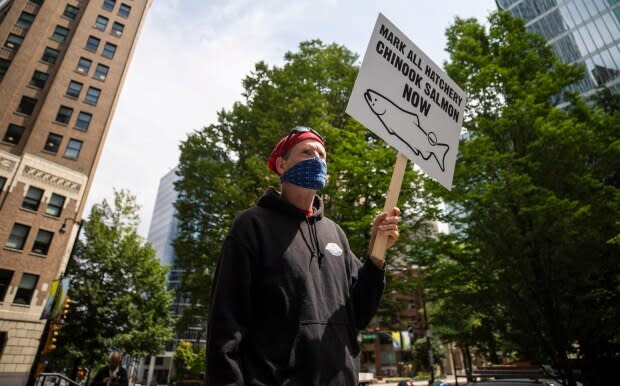Recreational anglers rally against chinook fishery closures
A angling advocacy group rallied outside the Vancouver offices of Fisheries and Oceans Canada on Monday to protest restrictions on recreational salmon fishery on B.C.'s South Coast.
On June 19, Fisheries and Oceans Canada announced that because of the presence of endangered Fraser chinook, recreational fishers would not be permitted to keep any chinook until July 15 in most areas, and until August 1 in the Strait of Juan de Fuca and Southern Strait of Georgia.
Last year the fishery was also shut down but for a shorter period of time.
Dave Brown, who organized the rally with Public Fishery Alliance and who calls himself a recreational angler, said the closure is ineffective in helping endangered stocks. He said there is no comprehensive plan to address more sustained threats like water extraction, habitat degradation, predation from seals and illegal netting.
"In the five years that Liberal ministers have been in charge of fisheries, they've not come up with a real recovery plan for the upper Fraser stocks of concerns," Brown said.
"What we are asking for is an actual recovery plan."
By closing the recreational fishery, Brown said the government is sending the wrong message that anglers are responsible for diminishing stocks.

Jeff Grout, regional resource manager for Fisheries and Oceans Canada, said the shutdown is necessary because threatened stocks mix with more plentiful chinook varieties in South Coast waters .
"Last year in particular we realized that a number of these populations were likely to keep declining even with extremely low fishing removals," he said.
"So we've been trying to keep the fishing removal as low as possible to get as many fish as we can back to the spawning grounds to allow them to spawn and carry the populations on."
Grout saidFirst Nations food, social and ceremonial fisheries have also been strictly curtailed in the critical areas.
Brown's group says the fishery could be better managed if hatchery chinook were marked by having their adipose fin clipped.
This would allow for easy identification of endangered wild salmon and abundant hatchery salmon, he said, the idea being that hatchery salmon would be kept and wild salmon released.
Currently, only 10 per cent of B.C. hatchery chinook are clipped.

"We're not asking them to raise more, just to mark them," Brown said. "This would allow for angling opportunities, allow for proper identification of wild fish and protect stocks that we are not wanting to be retained."
But Grout says a major consideration is the 20 per cent mortality rate that comes with catch and release.
"We still need to consider the potential impacts on wild chinook," he said.
According to Fisheries and Oceans Canada, 12 of 13 wild Fraser River chinook salmon populations assessed by the Committee on the Status of Endangered Wildlife in Canada are considered at risk.
Struggling Fraser River salmon stocks were put at further risk last year when a major rock slide blocked the river near Big Bar, north of Lilooet, which resulted in an almost complete loss of the 2019 early salmon run in the upper Fraser.
Work continues at the slide site to clear the blockage and find ways to allow fish to continue their spawning journey.
So far a salmon ladder and "natural fishway" have been constructed.
Additionally a "salmon cannon," or pneumatic tube system that moves spawning salmon over the slide site, is now operational.


